Health & Social Care: Promoting Inclusion for People with Disabilities
VerifiedAdded on 2023/06/10
|8
|2742
|113
Essay
AI Summary
This essay examines the dimensions of disability and its impact on health and social care, particularly within the UK context. It highlights the inequalities faced by individuals with disabilities, including lower employment rates, education levels, and access to healthcare. The essay delves into the critical disability theory and the social model of disability, emphasizing the need for inclusive practices and person-centered care to improve the quality of life for disabled individuals. It also discusses relevant health and social care policies and legislation, such as the Equality Act 2010, human rights, and safeguarding measures, aimed at promoting equality and reducing discrimination. The essay concludes by underscoring the importance of implementing these policies effectively to support individuals with disabilities and ensure their inclusion in society.
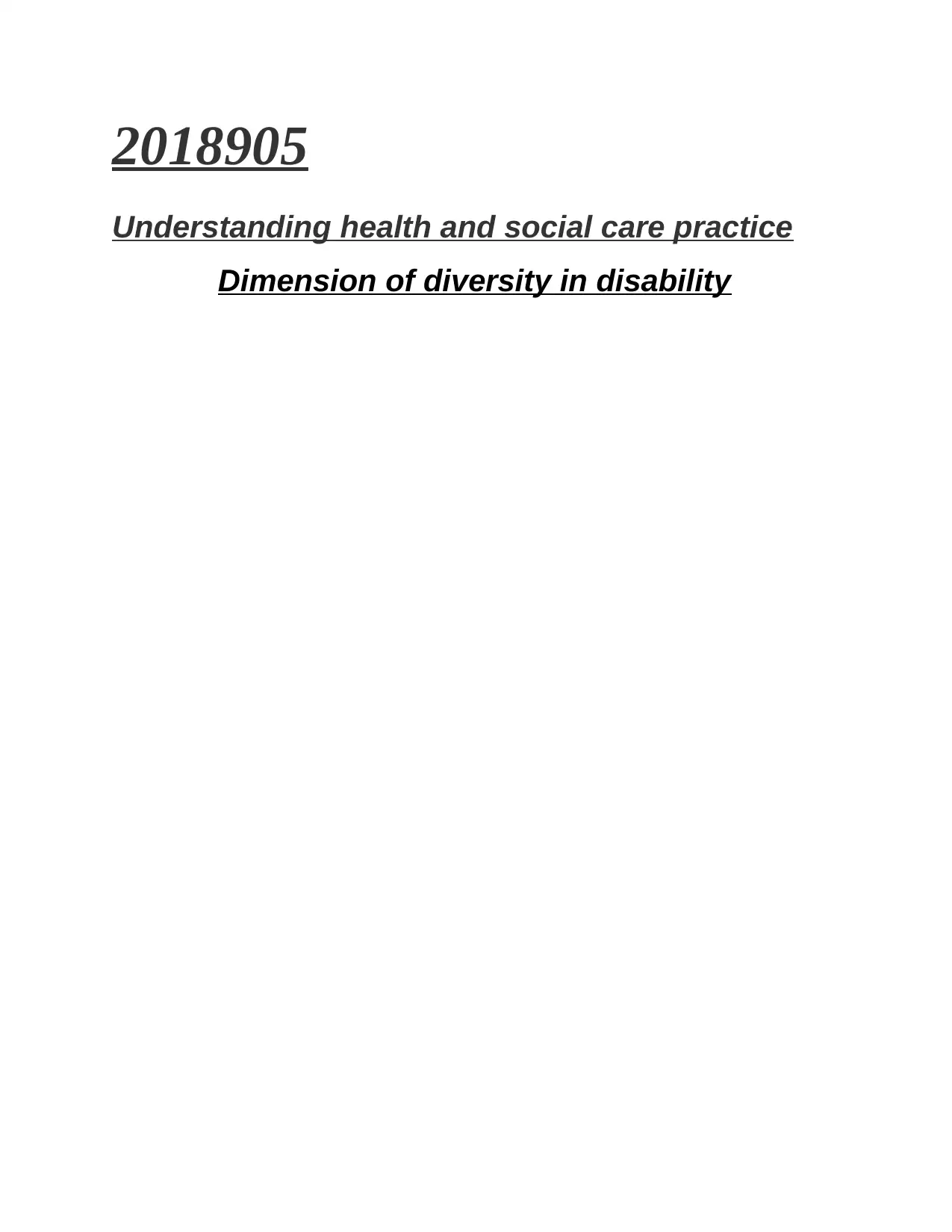
2018905
Understanding health and social care practice
Dimension of diversity in disability
Understanding health and social care practice
Dimension of diversity in disability
Paraphrase This Document
Need a fresh take? Get an instant paraphrase of this document with our AI Paraphraser
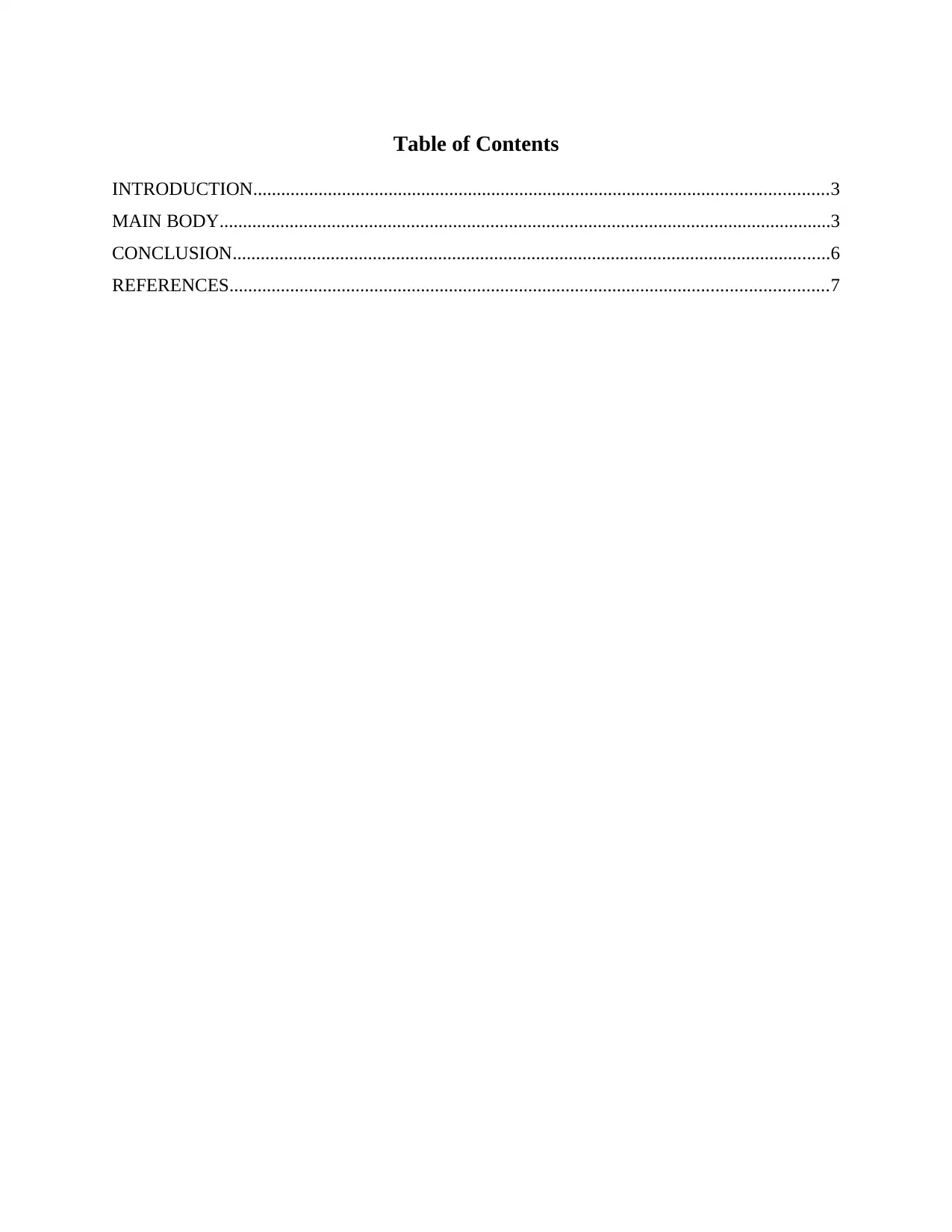
Table of Contents
INTRODUCTION...........................................................................................................................3
MAIN BODY...................................................................................................................................3
CONCLUSION................................................................................................................................6
REFERENCES................................................................................................................................7
INTRODUCTION...........................................................................................................................3
MAIN BODY...................................................................................................................................3
CONCLUSION................................................................................................................................6
REFERENCES................................................................................................................................7
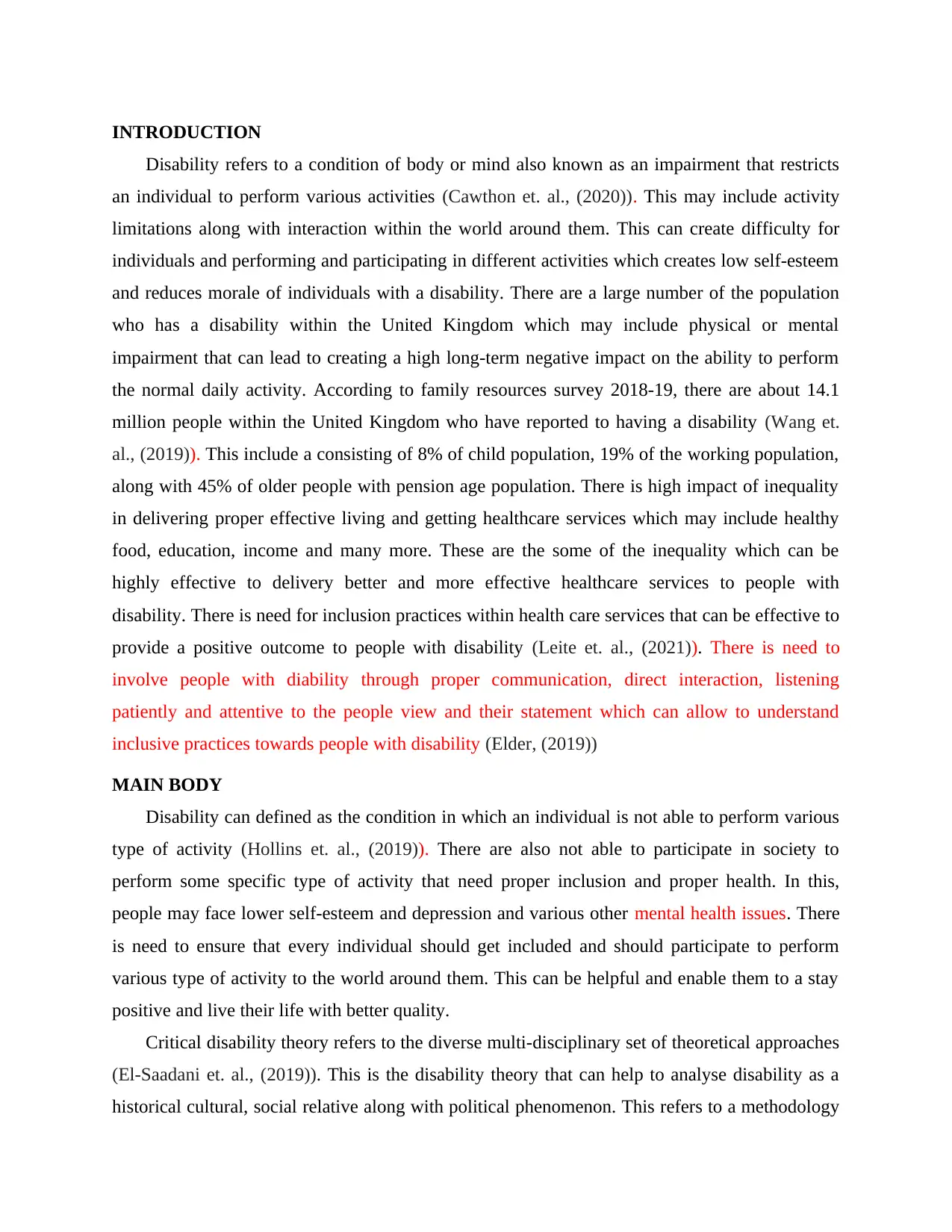
INTRODUCTION
Disability refers to a condition of body or mind also known as an impairment that restricts
an individual to perform various activities (Cawthon et. al., (2020)). This may include activity
limitations along with interaction within the world around them. This can create difficulty for
individuals and performing and participating in different activities which creates low self-esteem
and reduces morale of individuals with a disability. There are a large number of the population
who has a disability within the United Kingdom which may include physical or mental
impairment that can lead to creating a high long-term negative impact on the ability to perform
the normal daily activity. According to family resources survey 2018-19, there are about 14.1
million people within the United Kingdom who have reported to having a disability (Wang et.
al., (2019)). This include a consisting of 8% of child population, 19% of the working population,
along with 45% of older people with pension age population. There is high impact of inequality
in delivering proper effective living and getting healthcare services which may include healthy
food, education, income and many more. These are the some of the inequality which can be
highly effective to delivery better and more effective healthcare services to people with
disability. There is need for inclusion practices within health care services that can be effective to
provide a positive outcome to people with disability (Leite et. al., (2021)). There is need to
involve people with diability through proper communication, direct interaction, listening
patiently and attentive to the people view and their statement which can allow to understand
inclusive practices towards people with disability (Elder, (2019))
MAIN BODY
Disability can defined as the condition in which an individual is not able to perform various
type of activity (Hollins et. al., (2019)). There are also not able to participate in society to
perform some specific type of activity that need proper inclusion and proper health. In this,
people may face lower self-esteem and depression and various other mental health issues. There
is need to ensure that every individual should get included and should participate to perform
various type of activity to the world around them. This can be helpful and enable them to a stay
positive and live their life with better quality.
Critical disability theory refers to the diverse multi-disciplinary set of theoretical approaches
(El-Saadani et. al., (2019)). This is the disability theory that can help to analyse disability as a
historical cultural, social relative along with political phenomenon. This refers to a methodology
Disability refers to a condition of body or mind also known as an impairment that restricts
an individual to perform various activities (Cawthon et. al., (2020)). This may include activity
limitations along with interaction within the world around them. This can create difficulty for
individuals and performing and participating in different activities which creates low self-esteem
and reduces morale of individuals with a disability. There are a large number of the population
who has a disability within the United Kingdom which may include physical or mental
impairment that can lead to creating a high long-term negative impact on the ability to perform
the normal daily activity. According to family resources survey 2018-19, there are about 14.1
million people within the United Kingdom who have reported to having a disability (Wang et.
al., (2019)). This include a consisting of 8% of child population, 19% of the working population,
along with 45% of older people with pension age population. There is high impact of inequality
in delivering proper effective living and getting healthcare services which may include healthy
food, education, income and many more. These are the some of the inequality which can be
highly effective to delivery better and more effective healthcare services to people with
disability. There is need for inclusion practices within health care services that can be effective to
provide a positive outcome to people with disability (Leite et. al., (2021)). There is need to
involve people with diability through proper communication, direct interaction, listening
patiently and attentive to the people view and their statement which can allow to understand
inclusive practices towards people with disability (Elder, (2019))
MAIN BODY
Disability can defined as the condition in which an individual is not able to perform various
type of activity (Hollins et. al., (2019)). There are also not able to participate in society to
perform some specific type of activity that need proper inclusion and proper health. In this,
people may face lower self-esteem and depression and various other mental health issues. There
is need to ensure that every individual should get included and should participate to perform
various type of activity to the world around them. This can be helpful and enable them to a stay
positive and live their life with better quality.
Critical disability theory refers to the diverse multi-disciplinary set of theoretical approaches
(El-Saadani et. al., (2019)). This is the disability theory that can help to analyse disability as a
historical cultural, social relative along with political phenomenon. This refers to a methodology
⊘ This is a preview!⊘
Do you want full access?
Subscribe today to unlock all pages.

Trusted by 1+ million students worldwide
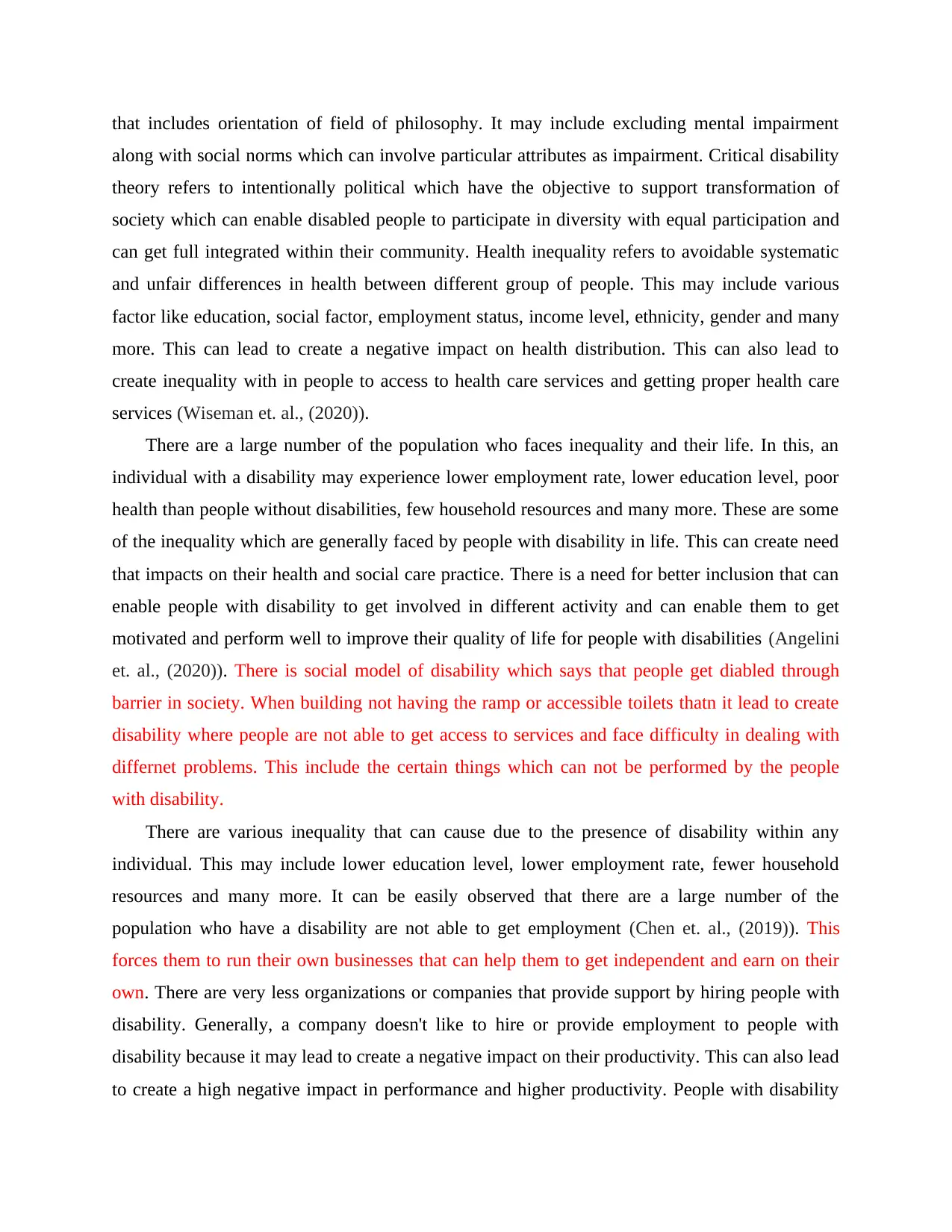
that includes orientation of field of philosophy. It may include excluding mental impairment
along with social norms which can involve particular attributes as impairment. Critical disability
theory refers to intentionally political which have the objective to support transformation of
society which can enable disabled people to participate in diversity with equal participation and
can get full integrated within their community. Health inequality refers to avoidable systematic
and unfair differences in health between different group of people. This may include various
factor like education, social factor, employment status, income level, ethnicity, gender and many
more. This can lead to create a negative impact on health distribution. This can also lead to
create inequality with in people to access to health care services and getting proper health care
services (Wiseman et. al., (2020)).
There are a large number of the population who faces inequality and their life. In this, an
individual with a disability may experience lower employment rate, lower education level, poor
health than people without disabilities, few household resources and many more. These are some
of the inequality which are generally faced by people with disability in life. This can create need
that impacts on their health and social care practice. There is a need for better inclusion that can
enable people with disability to get involved in different activity and can enable them to get
motivated and perform well to improve their quality of life for people with disabilities (Angelini
et. al., (2020)). There is social model of disability which says that people get diabled through
barrier in society. When building not having the ramp or accessible toilets thatn it lead to create
disability where people are not able to get access to services and face difficulty in dealing with
differnet problems. This include the certain things which can not be performed by the people
with disability.
There are various inequality that can cause due to the presence of disability within any
individual. This may include lower education level, lower employment rate, fewer household
resources and many more. It can be easily observed that there are a large number of the
population who have a disability are not able to get employment (Chen et. al., (2019)). This
forces them to run their own businesses that can help them to get independent and earn on their
own. There are very less organizations or companies that provide support by hiring people with
disability. Generally, a company doesn't like to hire or provide employment to people with
disability because it may lead to create a negative impact on their productivity. This can also lead
to create a high negative impact in performance and higher productivity. People with disability
along with social norms which can involve particular attributes as impairment. Critical disability
theory refers to intentionally political which have the objective to support transformation of
society which can enable disabled people to participate in diversity with equal participation and
can get full integrated within their community. Health inequality refers to avoidable systematic
and unfair differences in health between different group of people. This may include various
factor like education, social factor, employment status, income level, ethnicity, gender and many
more. This can lead to create a negative impact on health distribution. This can also lead to
create inequality with in people to access to health care services and getting proper health care
services (Wiseman et. al., (2020)).
There are a large number of the population who faces inequality and their life. In this, an
individual with a disability may experience lower employment rate, lower education level, poor
health than people without disabilities, few household resources and many more. These are some
of the inequality which are generally faced by people with disability in life. This can create need
that impacts on their health and social care practice. There is a need for better inclusion that can
enable people with disability to get involved in different activity and can enable them to get
motivated and perform well to improve their quality of life for people with disabilities (Angelini
et. al., (2020)). There is social model of disability which says that people get diabled through
barrier in society. When building not having the ramp or accessible toilets thatn it lead to create
disability where people are not able to get access to services and face difficulty in dealing with
differnet problems. This include the certain things which can not be performed by the people
with disability.
There are various inequality that can cause due to the presence of disability within any
individual. This may include lower education level, lower employment rate, fewer household
resources and many more. It can be easily observed that there are a large number of the
population who have a disability are not able to get employment (Chen et. al., (2019)). This
forces them to run their own businesses that can help them to get independent and earn on their
own. There are very less organizations or companies that provide support by hiring people with
disability. Generally, a company doesn't like to hire or provide employment to people with
disability because it may lead to create a negative impact on their productivity. This can also lead
to create a high negative impact in performance and higher productivity. People with disability
Paraphrase This Document
Need a fresh take? Get an instant paraphrase of this document with our AI Paraphraser
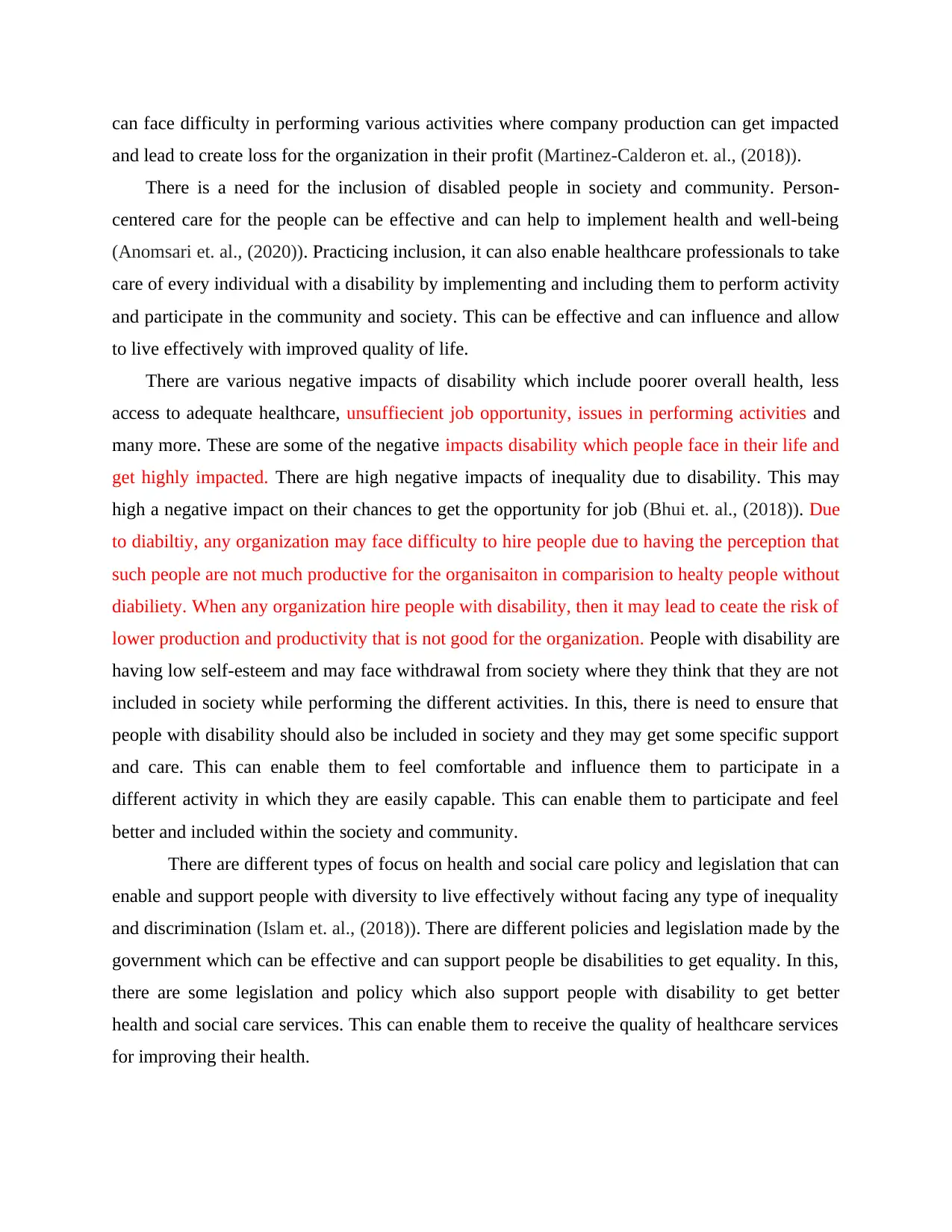
can face difficulty in performing various activities where company production can get impacted
and lead to create loss for the organization in their profit (Martinez-Calderon et. al., (2018)).
There is a need for the inclusion of disabled people in society and community. Person-
centered care for the people can be effective and can help to implement health and well-being
(Anomsari et. al., (2020)). Practicing inclusion, it can also enable healthcare professionals to take
care of every individual with a disability by implementing and including them to perform activity
and participate in the community and society. This can be effective and can influence and allow
to live effectively with improved quality of life.
There are various negative impacts of disability which include poorer overall health, less
access to adequate healthcare, unsuffiecient job opportunity, issues in performing activities and
many more. These are some of the negative impacts disability which people face in their life and
get highly impacted. There are high negative impacts of inequality due to disability. This may
high a negative impact on their chances to get the opportunity for job (Bhui et. al., (2018)). Due
to diabiltiy, any organization may face difficulty to hire people due to having the perception that
such people are not much productive for the organisaiton in comparision to healty people without
diabiliety. When any organization hire people with disability, then it may lead to ceate the risk of
lower production and productivity that is not good for the organization. People with disability are
having low self-esteem and may face withdrawal from society where they think that they are not
included in society while performing the different activities. In this, there is need to ensure that
people with disability should also be included in society and they may get some specific support
and care. This can enable them to feel comfortable and influence them to participate in a
different activity in which they are easily capable. This can enable them to participate and feel
better and included within the society and community.
There are different types of focus on health and social care policy and legislation that can
enable and support people with diversity to live effectively without facing any type of inequality
and discrimination (Islam et. al., (2018)). There are different policies and legislation made by the
government which can be effective and can support people be disabilities to get equality. In this,
there are some legislation and policy which also support people with disability to get better
health and social care services. This can enable them to receive the quality of healthcare services
for improving their health.
and lead to create loss for the organization in their profit (Martinez-Calderon et. al., (2018)).
There is a need for the inclusion of disabled people in society and community. Person-
centered care for the people can be effective and can help to implement health and well-being
(Anomsari et. al., (2020)). Practicing inclusion, it can also enable healthcare professionals to take
care of every individual with a disability by implementing and including them to perform activity
and participate in the community and society. This can be effective and can influence and allow
to live effectively with improved quality of life.
There are various negative impacts of disability which include poorer overall health, less
access to adequate healthcare, unsuffiecient job opportunity, issues in performing activities and
many more. These are some of the negative impacts disability which people face in their life and
get highly impacted. There are high negative impacts of inequality due to disability. This may
high a negative impact on their chances to get the opportunity for job (Bhui et. al., (2018)). Due
to diabiltiy, any organization may face difficulty to hire people due to having the perception that
such people are not much productive for the organisaiton in comparision to healty people without
diabiliety. When any organization hire people with disability, then it may lead to ceate the risk of
lower production and productivity that is not good for the organization. People with disability are
having low self-esteem and may face withdrawal from society where they think that they are not
included in society while performing the different activities. In this, there is need to ensure that
people with disability should also be included in society and they may get some specific support
and care. This can enable them to feel comfortable and influence them to participate in a
different activity in which they are easily capable. This can enable them to participate and feel
better and included within the society and community.
There are different types of focus on health and social care policy and legislation that can
enable and support people with diversity to live effectively without facing any type of inequality
and discrimination (Islam et. al., (2018)). There are different policies and legislation made by the
government which can be effective and can support people be disabilities to get equality. In this,
there are some legislation and policy which also support people with disability to get better
health and social care services. This can enable them to receive the quality of healthcare services
for improving their health.
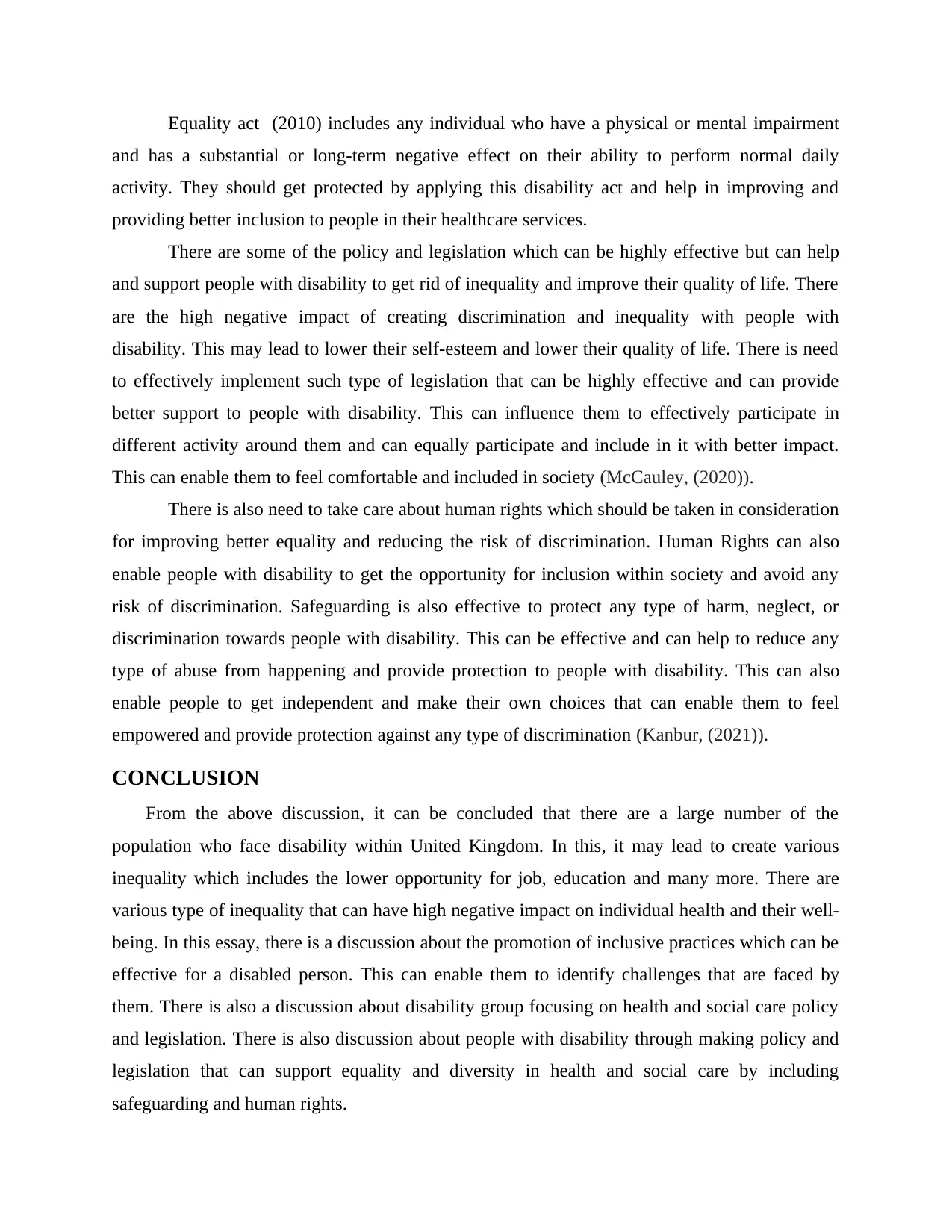
Equality act (2010) includes any individual who have a physical or mental impairment
and has a substantial or long-term negative effect on their ability to perform normal daily
activity. They should get protected by applying this disability act and help in improving and
providing better inclusion to people in their healthcare services.
There are some of the policy and legislation which can be highly effective but can help
and support people with disability to get rid of inequality and improve their quality of life. There
are the high negative impact of creating discrimination and inequality with people with
disability. This may lead to lower their self-esteem and lower their quality of life. There is need
to effectively implement such type of legislation that can be highly effective and can provide
better support to people with disability. This can influence them to effectively participate in
different activity around them and can equally participate and include in it with better impact.
This can enable them to feel comfortable and included in society (McCauley, (2020)).
There is also need to take care about human rights which should be taken in consideration
for improving better equality and reducing the risk of discrimination. Human Rights can also
enable people with disability to get the opportunity for inclusion within society and avoid any
risk of discrimination. Safeguarding is also effective to protect any type of harm, neglect, or
discrimination towards people with disability. This can be effective and can help to reduce any
type of abuse from happening and provide protection to people with disability. This can also
enable people to get independent and make their own choices that can enable them to feel
empowered and provide protection against any type of discrimination (Kanbur, (2021)).
CONCLUSION
From the above discussion, it can be concluded that there are a large number of the
population who face disability within United Kingdom. In this, it may lead to create various
inequality which includes the lower opportunity for job, education and many more. There are
various type of inequality that can have high negative impact on individual health and their well-
being. In this essay, there is a discussion about the promotion of inclusive practices which can be
effective for a disabled person. This can enable them to identify challenges that are faced by
them. There is also a discussion about disability group focusing on health and social care policy
and legislation. There is also discussion about people with disability through making policy and
legislation that can support equality and diversity in health and social care by including
safeguarding and human rights.
and has a substantial or long-term negative effect on their ability to perform normal daily
activity. They should get protected by applying this disability act and help in improving and
providing better inclusion to people in their healthcare services.
There are some of the policy and legislation which can be highly effective but can help
and support people with disability to get rid of inequality and improve their quality of life. There
are the high negative impact of creating discrimination and inequality with people with
disability. This may lead to lower their self-esteem and lower their quality of life. There is need
to effectively implement such type of legislation that can be highly effective and can provide
better support to people with disability. This can influence them to effectively participate in
different activity around them and can equally participate and include in it with better impact.
This can enable them to feel comfortable and included in society (McCauley, (2020)).
There is also need to take care about human rights which should be taken in consideration
for improving better equality and reducing the risk of discrimination. Human Rights can also
enable people with disability to get the opportunity for inclusion within society and avoid any
risk of discrimination. Safeguarding is also effective to protect any type of harm, neglect, or
discrimination towards people with disability. This can be effective and can help to reduce any
type of abuse from happening and provide protection to people with disability. This can also
enable people to get independent and make their own choices that can enable them to feel
empowered and provide protection against any type of discrimination (Kanbur, (2021)).
CONCLUSION
From the above discussion, it can be concluded that there are a large number of the
population who face disability within United Kingdom. In this, it may lead to create various
inequality which includes the lower opportunity for job, education and many more. There are
various type of inequality that can have high negative impact on individual health and their well-
being. In this essay, there is a discussion about the promotion of inclusive practices which can be
effective for a disabled person. This can enable them to identify challenges that are faced by
them. There is also a discussion about disability group focusing on health and social care policy
and legislation. There is also discussion about people with disability through making policy and
legislation that can support equality and diversity in health and social care by including
safeguarding and human rights.
⊘ This is a preview!⊘
Do you want full access?
Subscribe today to unlock all pages.

Trusted by 1+ million students worldwide
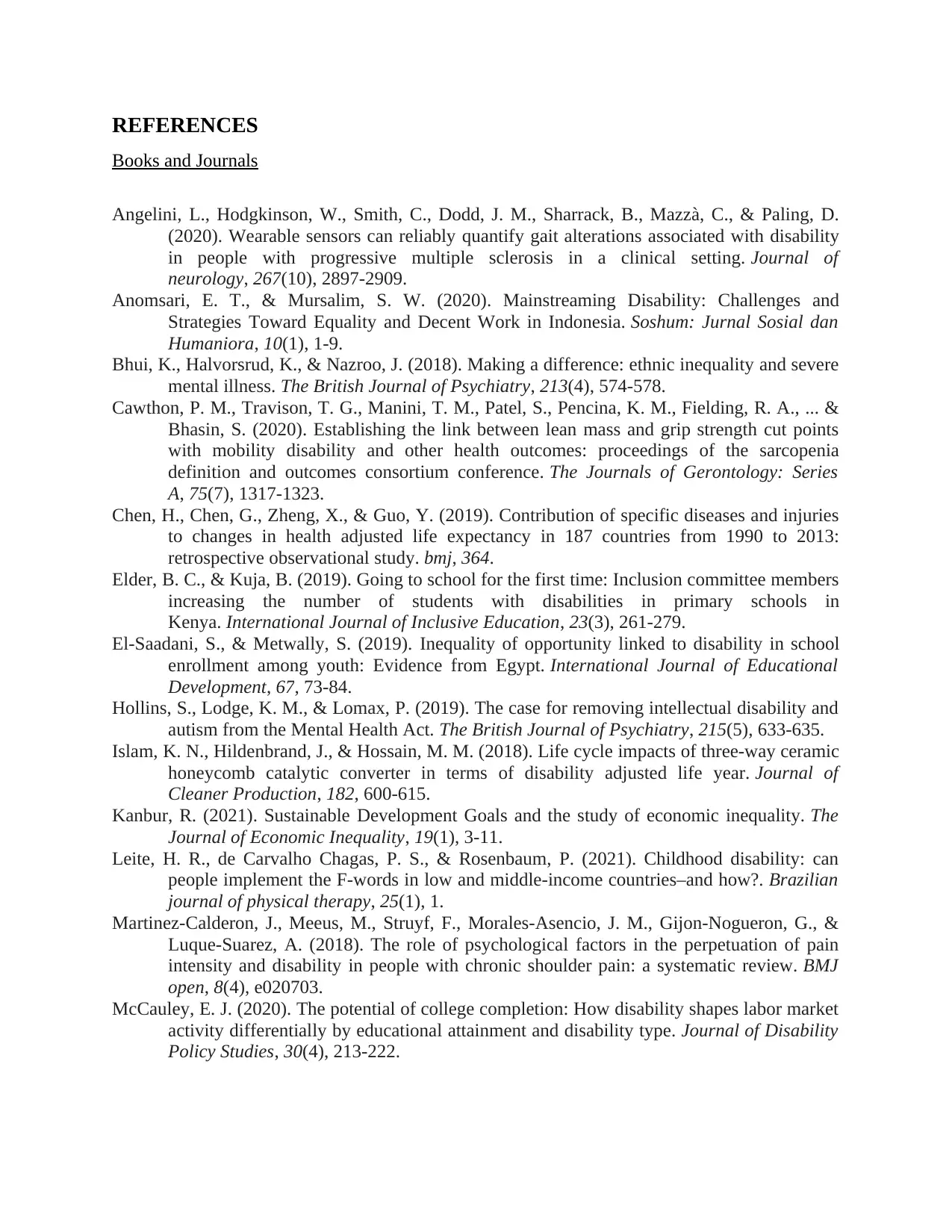
REFERENCES
Books and Journals
Angelini, L., Hodgkinson, W., Smith, C., Dodd, J. M., Sharrack, B., Mazzà, C., & Paling, D.
(2020). Wearable sensors can reliably quantify gait alterations associated with disability
in people with progressive multiple sclerosis in a clinical setting. Journal of
neurology, 267(10), 2897-2909.
Anomsari, E. T., & Mursalim, S. W. (2020). Mainstreaming Disability: Challenges and
Strategies Toward Equality and Decent Work in Indonesia. Soshum: Jurnal Sosial dan
Humaniora, 10(1), 1-9.
Bhui, K., Halvorsrud, K., & Nazroo, J. (2018). Making a difference: ethnic inequality and severe
mental illness. The British Journal of Psychiatry, 213(4), 574-578.
Cawthon, P. M., Travison, T. G., Manini, T. M., Patel, S., Pencina, K. M., Fielding, R. A., ... &
Bhasin, S. (2020). Establishing the link between lean mass and grip strength cut points
with mobility disability and other health outcomes: proceedings of the sarcopenia
definition and outcomes consortium conference. The Journals of Gerontology: Series
A, 75(7), 1317-1323.
Chen, H., Chen, G., Zheng, X., & Guo, Y. (2019). Contribution of specific diseases and injuries
to changes in health adjusted life expectancy in 187 countries from 1990 to 2013:
retrospective observational study. bmj, 364.
Elder, B. C., & Kuja, B. (2019). Going to school for the first time: Inclusion committee members
increasing the number of students with disabilities in primary schools in
Kenya. International Journal of Inclusive Education, 23(3), 261-279.
El-Saadani, S., & Metwally, S. (2019). Inequality of opportunity linked to disability in school
enrollment among youth: Evidence from Egypt. International Journal of Educational
Development, 67, 73-84.
Hollins, S., Lodge, K. M., & Lomax, P. (2019). The case for removing intellectual disability and
autism from the Mental Health Act. The British Journal of Psychiatry, 215(5), 633-635.
Islam, K. N., Hildenbrand, J., & Hossain, M. M. (2018). Life cycle impacts of three-way ceramic
honeycomb catalytic converter in terms of disability adjusted life year. Journal of
Cleaner Production, 182, 600-615.
Kanbur, R. (2021). Sustainable Development Goals and the study of economic inequality. The
Journal of Economic Inequality, 19(1), 3-11.
Leite, H. R., de Carvalho Chagas, P. S., & Rosenbaum, P. (2021). Childhood disability: can
people implement the F-words in low and middle-income countries–and how?. Brazilian
journal of physical therapy, 25(1), 1.
Martinez-Calderon, J., Meeus, M., Struyf, F., Morales-Asencio, J. M., Gijon-Nogueron, G., &
Luque-Suarez, A. (2018). The role of psychological factors in the perpetuation of pain
intensity and disability in people with chronic shoulder pain: a systematic review. BMJ
open, 8(4), e020703.
McCauley, E. J. (2020). The potential of college completion: How disability shapes labor market
activity differentially by educational attainment and disability type. Journal of Disability
Policy Studies, 30(4), 213-222.
Books and Journals
Angelini, L., Hodgkinson, W., Smith, C., Dodd, J. M., Sharrack, B., Mazzà, C., & Paling, D.
(2020). Wearable sensors can reliably quantify gait alterations associated with disability
in people with progressive multiple sclerosis in a clinical setting. Journal of
neurology, 267(10), 2897-2909.
Anomsari, E. T., & Mursalim, S. W. (2020). Mainstreaming Disability: Challenges and
Strategies Toward Equality and Decent Work in Indonesia. Soshum: Jurnal Sosial dan
Humaniora, 10(1), 1-9.
Bhui, K., Halvorsrud, K., & Nazroo, J. (2018). Making a difference: ethnic inequality and severe
mental illness. The British Journal of Psychiatry, 213(4), 574-578.
Cawthon, P. M., Travison, T. G., Manini, T. M., Patel, S., Pencina, K. M., Fielding, R. A., ... &
Bhasin, S. (2020). Establishing the link between lean mass and grip strength cut points
with mobility disability and other health outcomes: proceedings of the sarcopenia
definition and outcomes consortium conference. The Journals of Gerontology: Series
A, 75(7), 1317-1323.
Chen, H., Chen, G., Zheng, X., & Guo, Y. (2019). Contribution of specific diseases and injuries
to changes in health adjusted life expectancy in 187 countries from 1990 to 2013:
retrospective observational study. bmj, 364.
Elder, B. C., & Kuja, B. (2019). Going to school for the first time: Inclusion committee members
increasing the number of students with disabilities in primary schools in
Kenya. International Journal of Inclusive Education, 23(3), 261-279.
El-Saadani, S., & Metwally, S. (2019). Inequality of opportunity linked to disability in school
enrollment among youth: Evidence from Egypt. International Journal of Educational
Development, 67, 73-84.
Hollins, S., Lodge, K. M., & Lomax, P. (2019). The case for removing intellectual disability and
autism from the Mental Health Act. The British Journal of Psychiatry, 215(5), 633-635.
Islam, K. N., Hildenbrand, J., & Hossain, M. M. (2018). Life cycle impacts of three-way ceramic
honeycomb catalytic converter in terms of disability adjusted life year. Journal of
Cleaner Production, 182, 600-615.
Kanbur, R. (2021). Sustainable Development Goals and the study of economic inequality. The
Journal of Economic Inequality, 19(1), 3-11.
Leite, H. R., de Carvalho Chagas, P. S., & Rosenbaum, P. (2021). Childhood disability: can
people implement the F-words in low and middle-income countries–and how?. Brazilian
journal of physical therapy, 25(1), 1.
Martinez-Calderon, J., Meeus, M., Struyf, F., Morales-Asencio, J. M., Gijon-Nogueron, G., &
Luque-Suarez, A. (2018). The role of psychological factors in the perpetuation of pain
intensity and disability in people with chronic shoulder pain: a systematic review. BMJ
open, 8(4), e020703.
McCauley, E. J. (2020). The potential of college completion: How disability shapes labor market
activity differentially by educational attainment and disability type. Journal of Disability
Policy Studies, 30(4), 213-222.
Paraphrase This Document
Need a fresh take? Get an instant paraphrase of this document with our AI Paraphraser
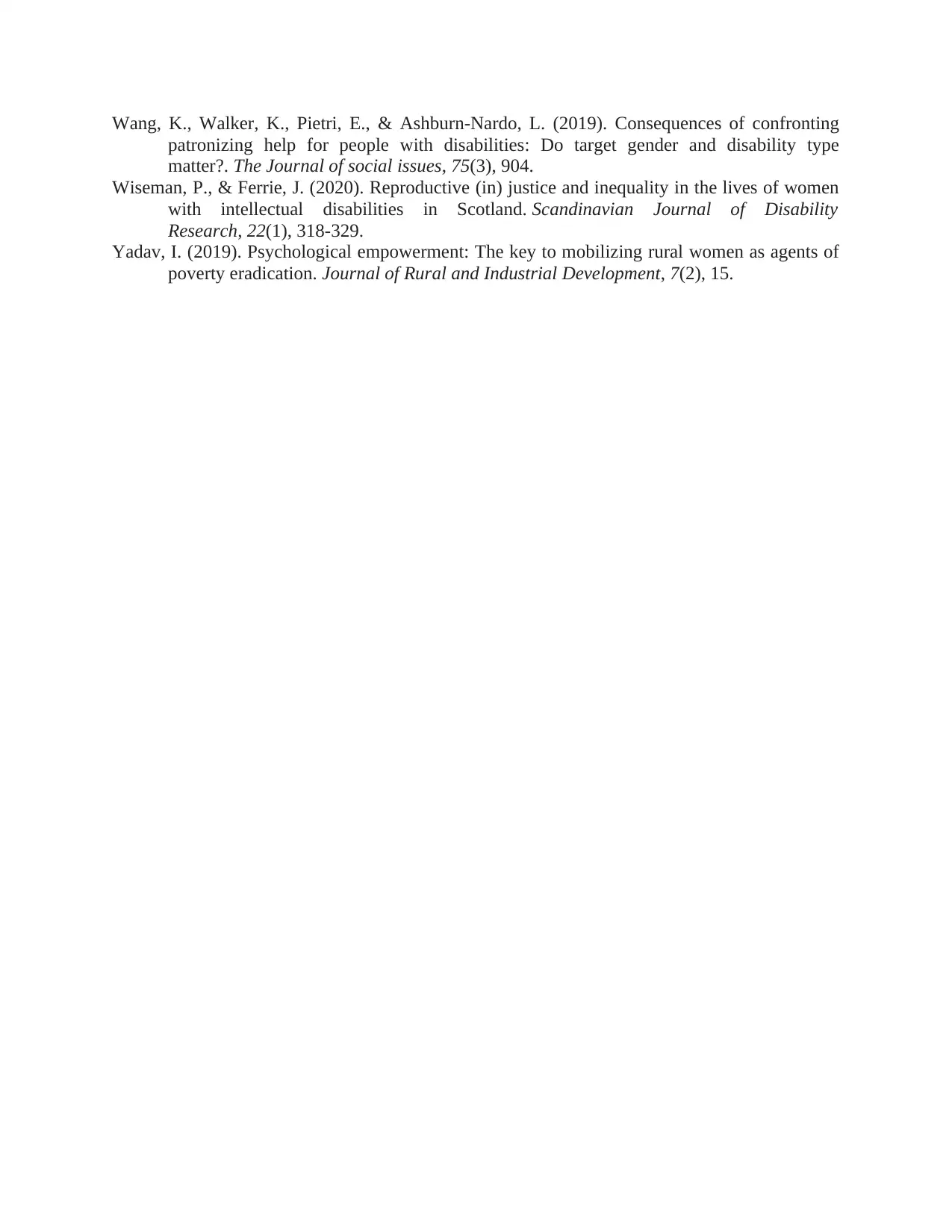
Wang, K., Walker, K., Pietri, E., & Ashburn-Nardo, L. (2019). Consequences of confronting
patronizing help for people with disabilities: Do target gender and disability type
matter?. The Journal of social issues, 75(3), 904.
Wiseman, P., & Ferrie, J. (2020). Reproductive (in) justice and inequality in the lives of women
with intellectual disabilities in Scotland. Scandinavian Journal of Disability
Research, 22(1), 318-329.
Yadav, I. (2019). Psychological empowerment: The key to mobilizing rural women as agents of
poverty eradication. Journal of Rural and Industrial Development, 7(2), 15.
patronizing help for people with disabilities: Do target gender and disability type
matter?. The Journal of social issues, 75(3), 904.
Wiseman, P., & Ferrie, J. (2020). Reproductive (in) justice and inequality in the lives of women
with intellectual disabilities in Scotland. Scandinavian Journal of Disability
Research, 22(1), 318-329.
Yadav, I. (2019). Psychological empowerment: The key to mobilizing rural women as agents of
poverty eradication. Journal of Rural and Industrial Development, 7(2), 15.
1 out of 8
Related Documents
Your All-in-One AI-Powered Toolkit for Academic Success.
+13062052269
info@desklib.com
Available 24*7 on WhatsApp / Email
![[object Object]](/_next/static/media/star-bottom.7253800d.svg)
Unlock your academic potential
Copyright © 2020–2025 A2Z Services. All Rights Reserved. Developed and managed by ZUCOL.





